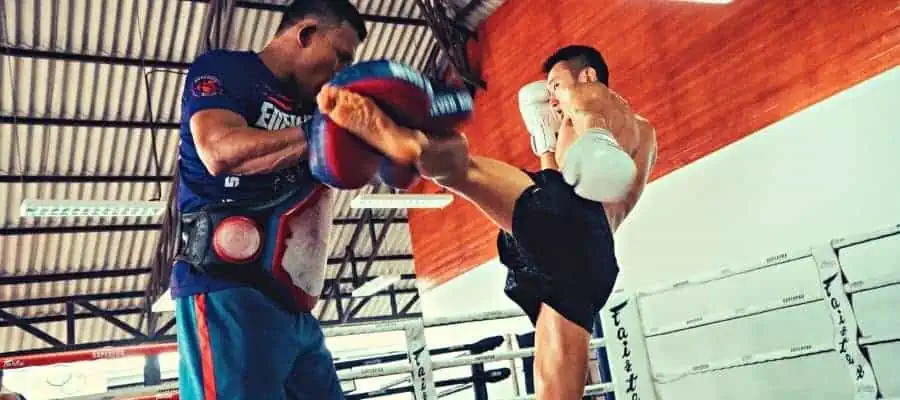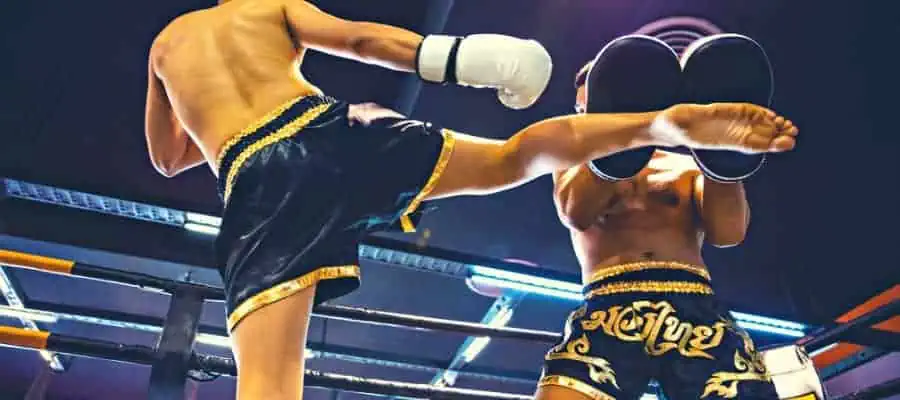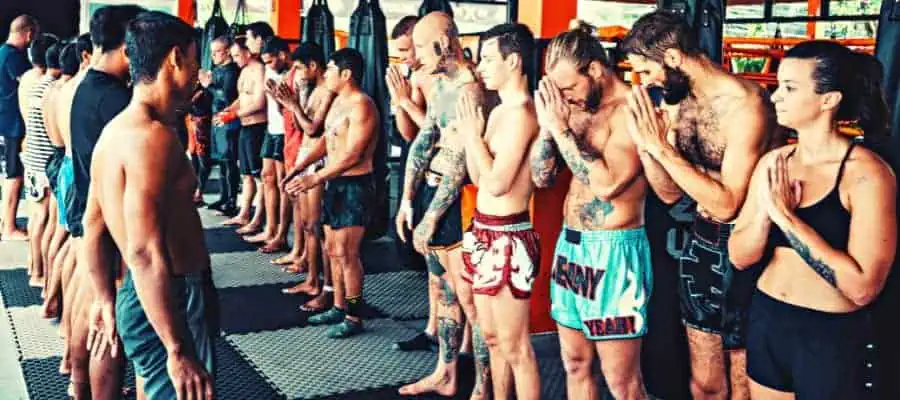Muay Thai is arguably the most complex, multidimensional striking art there is. And with the unique nature of the art, body type is a fundamental factor.
So, which build reigns supreme in the ring, and more importantly, how? A short, mesomorphic body type is the optimum for Muay Thai. Reasons include shorter distance to target allowing for faster strikes; higher levels of torque and leverage can be achieved faster; explosive, dense musculature increases strike power and defensive ability.
The most critical aspect, however, is always fighting IQ. Good technique can make you a perfect fighter with any build if you understand your strengths and weaknesses. The particulars of your body type will help you develop a fuller style and a deeper understanding of specific techniques, which is critical for developing your game.
Different Body Types And Their Styles

The Tall, Lanky Build (Ectomorphic)
Strikers, especially Muay Thai practitioners, know that someone who knows how to use their reach is extremely dangerous. They can keep you out at a distance with teeps (push kicks) and straight punches, but if you get too close, you risk getting sliced by an unusually sharp elbow.
These guys also hit harder than you might think since they can generate so much inertia with their limbs, almost like whips. Also, the clinch is particularly difficult to maneuver while fighting against this body type, as they can use frames better than most.
If a good in-fighter can get past their abnormal reach, they will have a harder time landing blows and will have to get out of the pocket (which is much easier said than done). Also, strikes thrown by these fighters are inevitably slower since the distance from the starting position to the opponent is greater.
Slower strikes mean more opportunities to defend and counterattack, the main weakness of this body type. Another important drawback is the higher center of gravity since that trait makes it easier to be swept.
Stylistically, this sort of build thrives out-fighting. If the fighter has good timing and can get out of the pocket consistently, their opponent is in for a tough match. It is typically best to stay out of the clinch, but when in that position, frames are going to be vital to staying safe.
Leg kicks may prove themselves useful since they will limit the opponent’s ability to move, thus lowering the chance of having to in-fight. Elbows are also very useful for this kind of fighter since it is their best option against in-fighters. In short, having a strong outside game will make you good, but being able to navigate in the pocket and the clinch will make you great.
The Heavy, Muscular Build (Endomorphic)
A bigger guy will hit significantly harder than a smaller guy. Big guys have remarkable knockout potential and are much harder to hurt due to bone and muscle density. Tying up with this class of fighter is not recommended since you’re likely to be slung around and battered with devastating blows.
Hooks, uppercuts, and other power punches are optimal for this build since the force and inertia behind them are so great. Roundhouse kicks are also particularly effective due to heavier legs and hips. This makes for a good chance at any range, particularly in the pocket.
When it comes to drawbacks, there is one that is obvious: mobility. With more weight, moving fast is going to be inevitably more laborious. While fighting in a weight class full of people that weigh the same, this isn’t much of a problem, but at the gym, you can fight anyone, which is when this drawback manifests itself most. A less obvious disadvantage is the commitment to moves.
When throwing a punch or kick, it is much harder to stop short since significant mass travels quickly. Simply put, an object in motion stays in motion, and the heavier the object, the more force is required to slow or stop it. This can lead to some big misses and end with getting hit five or six times.
Fighters this size need to choose their strikes wisely; otherwise, they risk major punishment. Therefore, fakes and reads are paramount, especially when fighting someone faster. With good reads, the potential for significant strikes increases, which is this body type’s specialty. Jabs will likely be the primary weapon since they have yet to be fully committed.
Still, they can set up power punches and clinch opportunities. Speaking of the clinch, tying up can be a game-changer, especially if done at the right time. Tying with an opponent who isn’t expecting it can lead to some big hits, primarily uppercuts, hooks, and knees. A big, bulky fighter with style like this can do some real damage to anyone with great effect.
The Short, Athletic Build (Mesomorphic)
The repertoire for this build of fighters is extremely diverse and adaptable. Nearly every move can be useful at some point for this fighter, but some moves shine particularly well. These moves include leg kicks, jabs, and attacks to the body. Leg kicks (specifically calf kicks) allow the fighter to slow and disarm the opponent, making it harder to keep up and, therefore, easier to hit.
This sort of fighter thrives on combos, which means that any move that allows them to combo off is of extreme utility, which brings us to the jab. Jabs shine at setting up combos, and they are more useful in the hands of someone fast and explosive. And to repeat an earlier point, slowing and disabling the opponent is worthwhile, making body kicks and punches very useful.
Again, a wide variety of moves are accessible to this sort of fighter, making this option quite flexible. Body strikes leave the opponent vulnerable, slow them down, and can even lower their stamina. This makes them one of the most valuable options for this sort of fighter and lets them pick their opponents apart over a reasonably short amount of time.
All of the moves done by this build are fast and powerful due to explosivity and shorter distances to travel. Leverage or torque will be much easier to achieve faster than any of the other body types. Footwork and defensive maneuvers are best suited to this body type, which can lead to devastating counterattacks.
This body type has some trouble in some areas, one being out-fighting. A shorter reach is an enormous disadvantage. Another drawback is the amount of energy used to get into the pocket and fight there. Cardio has to be a main focus at the gym, or tiring out is inevitable and not a good one.
What seems to be best suited for this body type is a defensive style focusing on the basics of the sport: footwork, head movement, and setting up good combos. Being able to work into the pocket is dependent on footwork and reading the opponent well. So it’s implied that moves that make it easier to get into the pocket will be the best, specifically body strikes and leg kicks.
These techniques weaken and slow the opponent so that it’s only a matter of time until a good liver shot lands or a knockout opportunity presents itself. However, if you have the chin and cardio of Nate Diaz, focusing on those long-term things may be optional (even though they are suggested).
What Is The Ideal Weight For Muay Thai?

The ideal weight depends on the person, but there are some general answers to the question. Training and working out for about a year will force your body to adapt. You may put on weight, or you may lose weight; it just depends.
A healthy diet can promote proper bodily function concerning this, however. In general, being lighter is better than being heavier in combat sports once you’ve found your proper weight. So, cutting for a tournament should prove helpful.
I have been cutting weight for many years of my life, and I can tell you from experience: there is a right way and a wrong way. Do not starve yourself or spit; these things are stupid and counterproductive. Your metabolism slows down if your body thinks it is starving, so eating breakfast is important. While you’re cutting, a couple of eggs and a banana should do the trick.
I usually skip lunch while cutting and eat a small dinner after training, at least 2 hours before bed. Proteins and complex carbs are good, but avoid high doses of simple carbs and sugars. One other thing you can try is a detox shake. Pineapple, cucumber, and apple cider vinegar will clear you out. Trust me. Just stick it in the blender with a couple of ice cubes and a splash of coconut milk, and don’t get too far from the toilet.
If you stick to this for about a week and train as usual, you should be good for weigh-ins. After weighing in, it’s tempting to gorge yourself on carbs and sugars. Don’t. A few simple carbs won’t hurt, but if you eat too much too fast, you’ll cramp and probably throw your guts up. Anyway, the whole point is don’t kill yourself for weigh-ins; worst-case scenario, you’ll get bumped up. It’ll be good practice for you.
How Old Is “Too Old” For Muay Thai?

Age is a huge factor when it comes to practicing any martial art, especially striking. As a lover of grappling, I always encourage older guys to get into jujitsu since it has much less impact on the joints and promotes “brain over brawn.” I would say that the upper limits for Muay Thai are around 40, but I’ve known people who are 55 and still spar.
It’s case by case because everyone’s body is different. Still, if you feel you’ve maintained yourself fairly well and have no major problems, go for it. Older people tend to be slower and weaker, meaning they have to use technique over athleticism (and a lot of older guys like that idea). So, this may be right for you if you want to flex your creative and strategic muscles.
If you have been practicing for a long time, you may be able to stay in it longer, granted you have few major injuries. People who have been doing Muay Thai for a long time have adapted to the high impact and fast movement, allowing their bodies to go longer than a new student’s. The most important factor is training partners.
Having a partner that moves at your pace and doesn’t put you in any danger is important. Some people like the rush of high-intensity sparring, making them a worse partner for an older person. Having a more methodical and technical partner will make for a great training session. It will help with the strategic component of the sport. Note older guys are not simply easy picking. As they say, an old man in a job where people die young is very dangerous.
How Do I Train My Body For Muay Thai?

Muay Thai is especially intense, making it like a HIIT (high interval impact training) workout in itself. However, this does not mean that you’ll instantly be a world-class athlete by going to class. It’s quite the opposite; to become a proficient practitioner, it’s important to train your body often. This means maintaining good cardio, flexibility, and strength.
Strength training is particularly important because it promotes bone density while increasing power simultaneously. Cardio is key; anyone who’s done any striking knows that. And maintaining good flexibility prevents injury and will help with those head kicks. So, hit the gym, do some running and jump rope, and stretch. If you do those things, your “extracurricular” training will help you to be a beast in the ring.
There is a strange dichotomy between overtraining and under-training. You want to train more than anyone (if you want to be the best), but you also don’t want to burn yourself out. Everyone is different in this aspect, so I encourage you to push your limit as far as possible and slowly tune back until you find what suits you. If you are more of a casual practitioner, then it would be best for you to get as much training as possible.
Remember what muscles you use when you fight when you go to the gym. For example, punch power is generated from the legs through the core, chest, and shoulders. Keep in mind that if you only bench, you’ll only increase punching power by a fraction. In other words, don’t skip leg day. Another thing to keep in mind is weight gain.
Most fighters don’t want to put on too much weight to stay in their current weight class. So, shredding may prove to be better than bulking. Body weight exercises, HIIT, cross fit, and similar workouts are optimal for fighters who like their weight and value explosive power.
Lastly, running is key whether you practice martial arts or not. It will strengthen those important tendons and ligaments in the legs and ankles while also increasing lung capacity and promoting blood flow. Running is the most substantial daily task any human can do. Studies even show that running can help sustain brain function into older age. If running was a pill, everyone would take it.
Conclusion
In conclusion, the complex and dynamic nature of Muay Thai makes the question of body type an intricate one. Investigating the plethora of types and styles is one way to find the answer, as seen above, leading to the answer. The answer is found in how the body is used, and if used properly, the short, mesomorphic type can reign supreme.
However, do not let this discourage you. Find your style and master it; no matter the type, you can and will be successful. Anyone can be an excellent practitioner with hard work, diligent training, a strong mindset, and some luck.
Recent Posts
What is Manachai's Fighting Style? Unveiling Muay Thai Mastery
Manachai, a celebrated figure in the Muay Thai world, has captivated audiences with his exemplary martial prowess. Hailing from the heartlands of Thailand, his name is synonymous with the art of...
What Was Chamuekpet Hapalang's Fighting Style? Unveiling Techniques
Chamuekpet Hapalang was a renowned figure in the world of Muay Thai (record 200-48-2), embodying a fusion of Muay Bouk and Muay Khao styles. Originating from Thailand, the art of Muay Thai is known...
